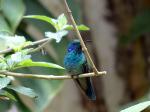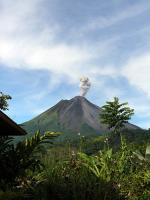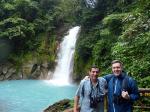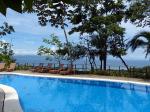Having been lucky enough to visit much of Central America, Costa Rica was one country whose passport stamp had still eluded me. Thankfully in May I was able to rectify this, spending two weeks visiting some of the country's highlights and lesser known areas - and finding some new discoveries for Last Frontiers along the way.
The Central Valley
My journey began in the country's capital, San José, one of the youngest capitals in Latin America and surrounded by volcanoes and mountains. The late development of San José, means you won't see the typical, colonial architecture that is found in other parts of Latin America, but it is still a city with charm. The capital is home to the National Museum, which was once a military barracks and came under heavy fire during the Civil War of 1948 - the bullets are still lodged in the exterior walls! The National Theatre, with its wonderfully over the top interior and regular performances, is worth a visit. San José is also a great place to sample the traditional Costa Rican dishes, such as 'Gallo Pinto' (rice and beans), which admittedly isn't quite as sophisticated as the cuisine in other parts of Latin America, but none-the-less tasty!
The majority of tourists arriving in Costa Rica, land at the international airport on the outskirts of San José. The dilemma is then whether to stay in the capital, or venture into the hills surrounding the city, home to agricultural communities and coffee plantations. I decided on the latter, and took one of the winding roads up into the hills, where I was greeted with spectacular views of the sprawling capital. The pace of life is far slower in the hills, and a complete contrast to the hustle and bustle of San José. There are a number of places to stay, ranging from colourful, modern properties, where the emphasis is very much on 'wellness' and relaxation, to the more traditional types of accommodation, including a coffee finca (farm), where you can see how the coffee is produced. I stayed at a beautiful lodge overlooked by the impressive Poas volcano. The owners of the lodge are British (old friends of Last Frontiers!), and this could be seen in the furniture and decor - the wingback chairs and fireplaces with roaring fires, certainly helped to give it that home from home feel. Whether you want to relax, or be active, there is so much to see and do when staying outside the capital - from hiking on volcanoes to drying your own coffee beans. I was definitely never bored!
My first stop away from the capital was the cloud forest of Monteverde - a birdwatchers’ paradise and home to over 400 different species, including the Resplendent Quetzal. The area was first inhabited in the 1950s, when a group of Quakers from North America left the USA to avoid being drafted into the army. After clearing the area for dairy farming, the community realised that the forest cover was actually essential in protecting the watershed of the area, and so in 1972 the reserve was created. The region's main town is Santa Elena, which is often shrouded in mist as the cold air from the Atlantic meets the warmer air from the Pacific. After a bumpy journey (driving on an unpaved road is known as a 'Costa Rican massage'!) I arrived in Santa Elena, which is where the majority of the hotels are to be found (quite a variety, from simple lodges to larger properties). The outstanding feature of the area is the Monteverde National Park, which is just outside the town and at its busiest from January to March. Outside these months it is relatively quiet - I must have seen a handful of people on my visit. During the 'green season' which extends from April to December, downpours are common, but they are generally short and sharp, occurring in the afternoon or overnight.
Northern Highlands and Lowlands
North of Monteverde is the popular tourist town of La Fortuna, which is flanked by the impressive Arenal volcano. Having travelled around much of Central and South America, I have seen my fair share of volcanoes, but I think Arenal may rank as my favourite. Although activity is now rare (it last exploded in 2010), its perfectly shaped cone dominates the sky line - I found myself taking endless photos. Arenal is a great place to base yourself, if you intend to be active. There are rivers which can be rafted, beautiful scenery to explore on horseback, hanging bridges to visit and even stand-up paddle boarding on Lake Arenal, a man-made lake formed in 1974 to provide hydroelectric power for the country. There is so much to keep you entertained that it really is a must for families - the town is also famous for its hot springs, the perfect place to relax and soothe tired muscles after a full day of activities.
One of the less frequently visited regions of Costa Rica is the Tenorio National Park, north-west of Arenal and La Fortuna. The park itself was only established in 1995, but has been rapidly adapted to tourism and now has a series of well-maintained walkways to explore. The highlight of the park is a 30 metre high waterfall, which crashes down into the beautiful, crystal blue Rio Celeste below (which literally translates as 'light blue river'). The water has a distinctive turquoise appearance due to the reaction of the sulphur from Tenorio volcano with the calcium carbonate found in the rocks. It isn't possible to stay in the park, but there are some lovely properties nearby, which makes access relatively easy. The park holds particularly fond memories for me as I spotted a sloth wrapped around one of the trees!
From Tenorio I travelled north into the country's sub-tropical lowlands to the remote village of Boca Tapada, close to the border with Nicaragua and an area which is still on the radar of very few tourists. I stayed at a family-run lodge, built on its own private reserve and accessed by a short boat ride across the impressive, caiman infested Rio San Carlos. The main attraction of the area is the wildlife - the reserve is home to over 400 species of birds, including the green and scarlet macaw (one of which came and sat opposite me whilst I ate breakfast!), and all kinds of wildlife from snakes and frogs to crocodiles and caimans. Guests stay in their own comfortable, private cabins, each with electricity, ceiling fans and hot water. The highlight for me was my private terrace (each cabin has one), overlooking the lagoon - a real treat at sunrise and sunset. The lodge has a series of self-guided trails into the forest, but there are other activities including riding, night hikes and boat trips to the Nicaraguan border town of Boca San Carlos (it is actually possible to do a day trip to Nicaragua). It was a beautiful place to stay and I was made to feel really at home.
The northern region of Guanacaste was my penultimate stop in Costa Rica. Close to the international airport of Liberia and the Nicaraguan border, the area itself is a tropical dry forest, completely different from other parts of the country. There are trails, hot springs and mud pools, but the highlight for me was the day I spent zip-lining through the Rio Blanco canyon.
The Osa Peninsula
My journey ended on the Osa Peninsula, Central America's answer to the Amazon rainforest. The peninsula is just a short flight from San José, and unlike the Amazon, it has a combination of virgin rainforest and deserted beaches. With over 2.5% of the world's species in less than a thousandth percent of the planet's surface area, it is one of the most diverse places on earth. Spotting wildlife isn't my strong point, but even I managed to see three different species of monkey amongst the trees (howler, spider and white-faced). If wildlife doesn't appeal, there are plenty of other things to keep you busy, from waterfall rappelling (which I tried but didn’t excel at) to diving and surfing. It is possible to stay on either side of the peninsula and there is quite a variety of accommodation, some of which are aimed more at families and active guests, and others with a more romantic and luxurious feel. Personally I liked a mixture of both, spending the days dangling next to a waterfall, and the evenings drinking gin and tonic by the pool - the tonic helped keep the mosquitoes away…
My time in Costa Rica was a real adventure and I enjoyed every minute. Although it doesn't have the colonial architecture and ancient ruins that you can find in other Central American countries, it does have beautiful beaches, wonderful wildlife and all kinds of activities to keep you busy. I think it is safe to say you will never be bored in Costa Rica - pura vida!









